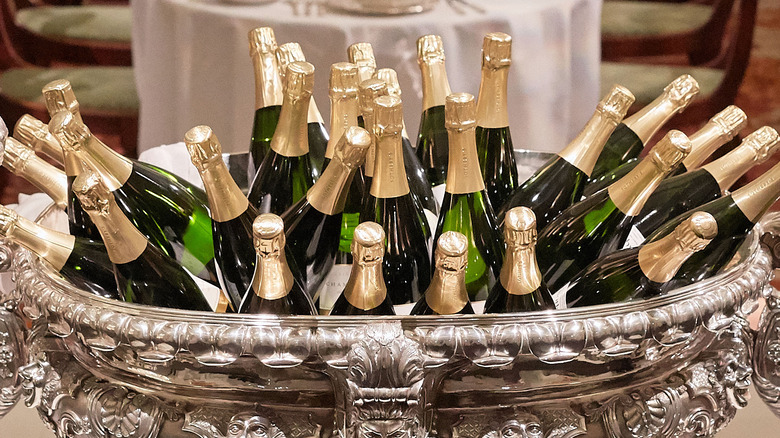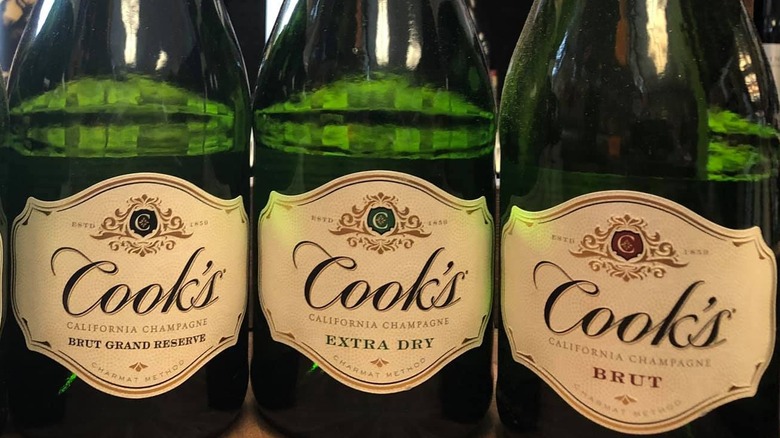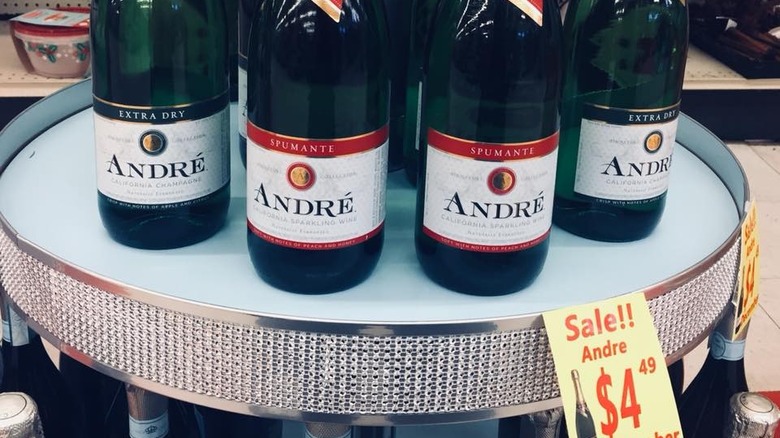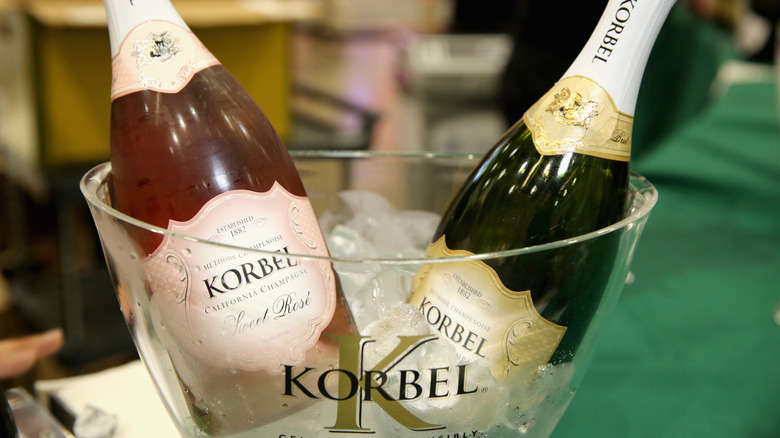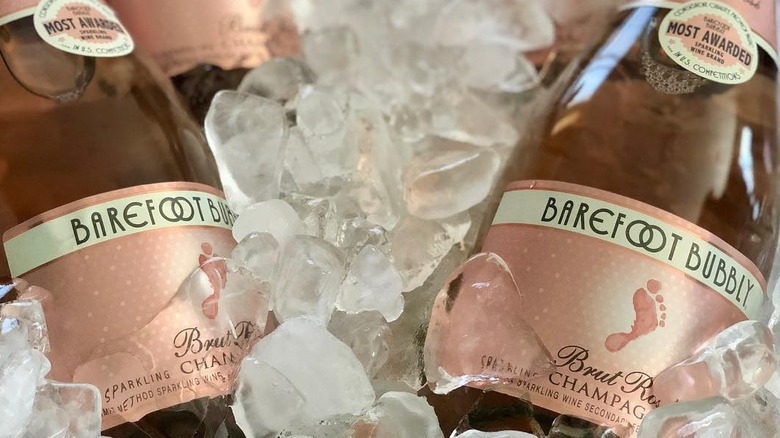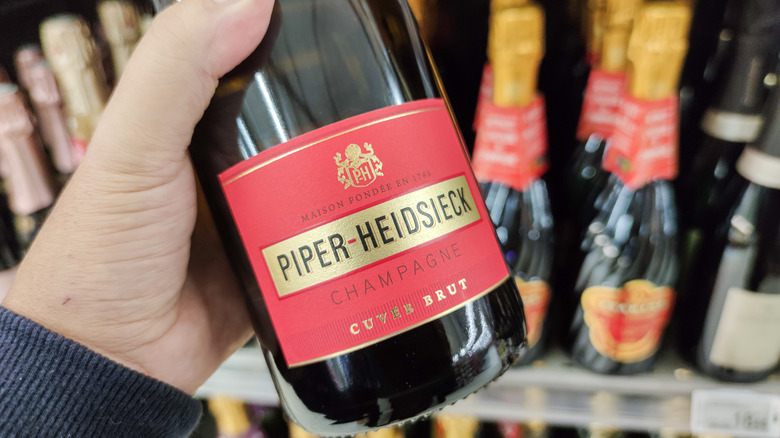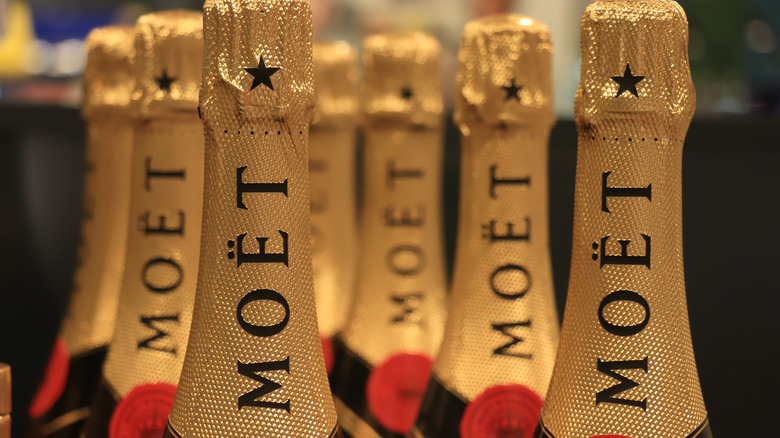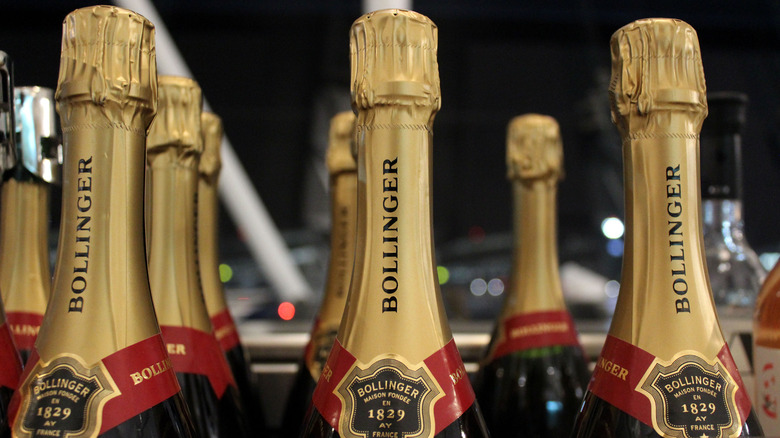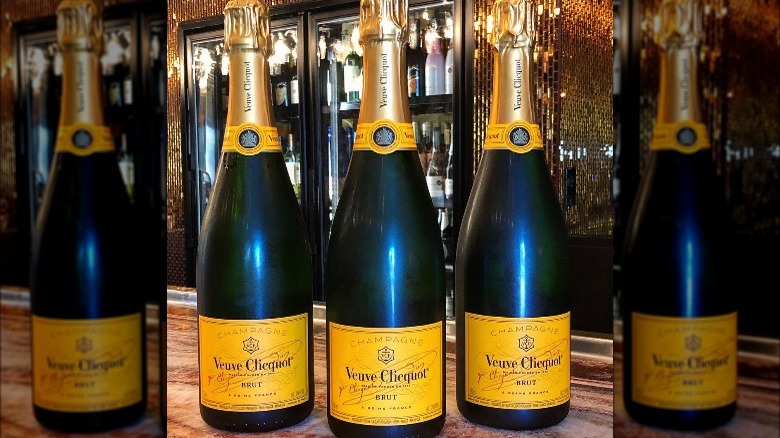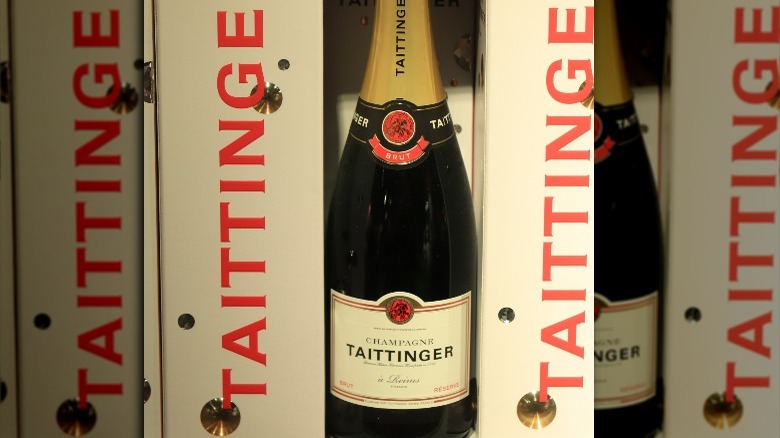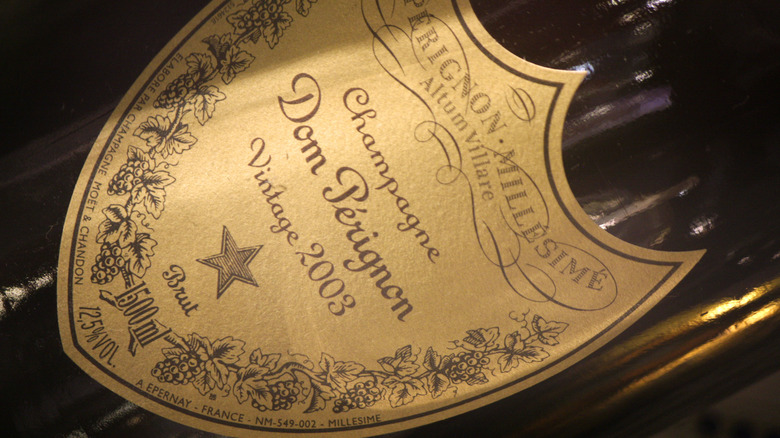10 Popular Champagne Brands Ranked From Worst To Best
Champagne is often the hallmark of a fine celebration, though, when copious glasses of bubbly were clinked the night before, your head could be paying the price the next morning. New Scientist reports that a British researcher conducted an experiment on 12 people, half of whom drank flat Champagne, and the other half consumed the fizzy stuff. Five minutes in, the alcohol levels of the bubbly drinkers were higher than the non-bubbly imbibers. So, it seems as if the bubbles are oftentimes the culprit for the pounding headache.
Or it could be the type of Champagne you imbibed. It's pretty good odds that a cheap bottle or can of Champagne has been artificially pumped up with bubbles and sugar (via Food Republic), and sugar causes dehydration. Combined with alcohol, you might just wake up with a headache so bad you'll keep the drapes and shades closed (and perhaps hide under the covers) for the rest of the day.
Now, it's true that expensive Champagne, imbibed in large enough quantities, can still produce that dreaded hangover. But in our opinion, you'll be sipping — not guzzling — that $100 bottle, so you'll be drinking less overall. And why not have nice Champagne anyway? To help you find the right glass of bubbly for you, we've curated a list of some of the best and worst Champagne brands out there.
10. Cook's
For Champagne to be considered authentic Champagne, it must be produced in France under very strict guidelines, using the Méthode Champenoise or Méthode Traditionelle (via VinePair). Yet, Californian winemakers have been making California Champagne since the 1860s. After a century-long battle with France, the U.S. agreed in 2005 to remove the "Champagne" designation from all sparkling wines, unless the producer was already using it prior to 2006.
One of the few producers excluded from the agreement was Cook's California Champagne. According to the company's website, Cook's is allegedly the producer of the first "American Champagne", and Cook's Brut is still a favorite for mimosas at brunches and bridal showers. Brut is French for dry, raw, or undefined, and per The Spruce Eats, should have less than 12 grams of sugar per liter. Brut Champagne is usually not fruit-forward, either.
Cook's Brut, however, is something else altogether. Sommelier Patrick Cappiello put himself through a blind taste test of cheap champagnes (via Boozist), and without calling it "swill," he noted that it was "aggressively bubbly" and overly sweet. Cook's California Champagne is, for many, just too sweet and simple to really enjoy it.
9. André
André California Champagne has been getting people feeling celebratory since 1966, and it's also an escapee from the U.S.-European Union agreement about what should and shouldn't be called Champagne. The company's website pretty much admits to being the cheap stuff for getting slammed at a brunch, tailgate, or ugly sweater party. The bottled André is still labeled as "naturally fermented" Champagne, but the canned André drops the illusion altogether by calling it "carbonated wine."
The Village Voice did several taste comparisons with other cheap wines and found André to be sweet and even a bit acrid, but not too bad overall. André gets relatively high marks from Savory Reviews for its color, moderate bubbles, and smoothness that makes it pretty gluggable, if not exactly exciting.
André is famous for its twist-off cap that can be screwed back on for making the rounds at other parties. But even the fans at Savory Reviews recommend pouring it in the kitchen or wrapping it up in a towel so friends won't know just what it is you're serving.
8. Korbel
According to VinePair, beginning with Ronald Reagan's inauguration in 1985, six subsequent Presidents and First Ladies have toasted to their administrations with Korbel California Champagne. Korbel isn't as cheap as Cook's or André, and the price difference of a few bucks may indeed make Korbel seem all the classier. But don't be fooled by the fancy label and aggressive marketing.
Korbel's real scam is labeling its sparkling wine as Méthode Champenoise, which, according to sommelier Patrick Cappiello (via Boozist), is a total lie. This method of fermentation is costly and time-consuming, which is why real Champagnes are expensive. Also, it's illegal to label a wine as Méthode Champenoise outside of Champagne, France, so we can't quite understand how Korbel gets away with it.
Before knowing he was blind-tasting Korbel, Cappiello thought its bubbles were unnatural, almost as if the wine had gone through a SodaStream. It also smelled and tasted like candy and was super acidic. Savory Reviews noted Korbel's bitter after taste and graded it lower than Cook's and André, dubbing Korbel the "Atlantic City of Champagne."
7. Barefoot Bubbly
The recognizable cheap brand Barefoot Wines has claimed to be the most awarded wine brand in the world, and Barefoot Bubbly has racked up its share of awards as well.
An intriguing feature of Barefoot's label is it actually tells the truth about what's inside the bottle. As a California sparkling wine, it's still arguably okay to call it Champagne, though it's technically sparkling wine made with the Charmat method. In the traditional Champagne-making method, the wine is fermented for a second time in the bottle. In the Charmat method, the wine is fermented again in pressurized tanks in a process that takes one to six weeks (via Illinois Sparkling Company).
Barefoot Bubbly currently has nine sparkling wines, half of which are pretty sugary. Wine Enthusiast rates the Brut Cuvée Chardonnay a high 88 points for its crisp mouthfeel, clean finish, and tiny bubbles. But Cheap Wine Ratings wasn't as blown away by it but fell in love with Barefoot's Pinot Grigio Champagne. To date, a bottle of Barefoot Bubbly costs under $10, quite a bargain for better-than-decent cheap Champagne. If you can stomach the sugar, it may be worth the price tag.
6. Piper-Heidsieck
According to Cosmopolitan, Marilyn Monroe kept a steady supply of Piper-Heidsieck Champagne in her kitchen so she could indulge in a pick-me-up whenever she liked. But Marilyn isn't the only movie star who's enjoyed a glass or two of Piper-Heidsieck. It's the official Champagne for the Academy Awards (per Hollywood Reporter) and often makes red-carpet appearances at film festivals.
Piper-Heidsieck's website really pushes the seductiveness of its Champagne, which may be alluring to some potential drinkers. It also has a rich history as one of France's oldest Champagne producers, ever since Marie Antoinette reportedly became the Champagne's first brand ambassador in 1785.
The brand's signature Cuvée Brut is a blend of Pinot Noir, Pinot Meunier, and Chardonnay (via VinePair) and is pretty well-regarded, given that it consistently rates at 90 points and above. What's more, Piper-Heidsieck is surprisingly affordable, meaning that the crisp, clean drink may well be within your budget.
5. Moët & Chandon
The favorite bubbly of both French political leader Napoleon Bonaparte and Britain's Queen Elizabeth II is reportedly Moët & Chandon, the largest Champagne producer in the world (per VinePair). Moët & Chandon is part of the huge LVMH luxury brand, and it's estimated that about 28 million bottles of the stuff are produced every year (via Social Vignerons).
Founded in 1743 by Dutch-French Claude Moët (which, by the way, is why his Champagne's proper pronunciation is "mwett" and not "mo-way"), according to the company website, it was really his grandson, Jean-Remy Moët, who introduced Champagne to the world. Napoleon awarded Jean-Remy the prestigious medal of the Légion d'honneur. Allegedly, Napoleon's troops invented the celebratory tradition of cracking open Champagne bottles with a saber.
Moët's most recent innovation is Ice Impérial, a Champagne specifically created to be poured over ice. Meanwhile, Moët & Chandon's flagship Brut Impérial ages in the bottle for a relatively short 24 months (the legal requirement is 18 months) and apparently has the aroma of maple syrup-drenched French toast with a squeeze of lemon. Generally scrumptious and modestly priced, Moët & Chandon is a royal Champagne that we non-royals love too, though there are more complex champagnes waiting out there.
4. Bollinger
If it weren't for "Absolutely Fabulous," you might never have heard of Bollinger. According to The Irish Times, Bollinger was considered to be an insufferably snobby Champagne, at least until Edina and Patsy upended its reputation by getting plastered courtesy of their favorite "Bolly" in many of the British sitcom's episodes.
Bollinger cashed in on its "AbFab" fame, but as reported by PR Week, struggled to justify its rather eyebrow-raising price tag. The brand eventually hired a public relations firm to restore its image as a premium Champagne worth your hard-earned money. Its recent release of a James Bond-themed Champagne (per VinePair) certainly helps.
Bollinger has a long legacy, dating back to 1829, and is today one of the few independent family-run Champagne producers in France. As reviewed by Bespoke Unit, Bollinger is a bit more expensive than competitors but produces some truly gorgeous, mature Champagnes that pair beautifully with savory foods. Wine Enthusiast is enthusiastic about Bollinger's Pinot Noir-dominated Special Cuvée Brut, rating it 92 points for its complex fermentation. Redolent with the aromas and flavor of buttery baked apples and a touch of hazelnut, Bollinger is perfect for a date night, though you may find the savory edge surprising.
3. Veuve Clicquot
Madame Clicquot shook up the business world in early 19th-century France when she assumed control of her recently dead husband's Champagne house. Called the "Grande Dame of Champagne," Madame Clicquot expanded the business, refined its Champagne-making process, and invented the first rose Champagne. As the company's website tells it, Madame Clicquot often said "I want my brand to rank first, from New York to Saint Petersburg." Today, Veuve (Widow) Clicquot is still guided by the original Madame Clicquot's vision. For many, it's simply one of the finest Champagnes in the world.
As reported by the BBC, in 2011, a Veuve Clicquot super-fan paid $43,900 at an auction for a 200-year-old bottle that had been recovered from a shipwreck. In effect, this was a bottle from Madame Clicquot's time. It's clear that fans of this stuff are pretty serious.
Bespoke Unit praised Veuve Clicquot's flagship yellow label as glimmering with "graceful yet energetic bubbles." Its aroma and taste are mirabelle plums, grapefruit, and cream with a toasty, nutty finish. The Drinks Business concurred, calling out Veuve Clicquot's harmonious blend of buttery, creamy, and bread-like notes with a tart sour-apple finish. Veuve Clicquot is available just about everywhere, though if you're worried about the price tag, you may need to time your purchase carefully. During the holidays, it's usually marked down, so it can be affordable for any celebration.
2. Taittinger
Taittinger is one of the few Champagne producers that ages their prestige Champagnes in the famous and ancient chalk caves of Reims (via Wine-Searcher). The caves, originally excavated by the Romans, were unearthed again in the 18th century and have since proven to be the ideal environment for aging Champagne. Except for a brief interlude, Taittinger has been a family-operated Champagne house since 1932.
Taittinger's website emphasizes that the "soul of the family business" is the key to making extraordinary Champagne. There must be something to the Taittinger philosophy after all, since International Wine Report rates their Champagnes from 90 to a startling 96 points. That last rating is for Taittinger's premium Cotes de Champagnes, which runs about $200 a bottle. If that's a bit rich for your blood, the Taittinger Brut la Francaise costs much less and is perfect for more casual dinner parties.
VinePair notes that this "alluring" Brut comes with flavors of "orchard fruit with nuances of citrus oil and parmesan rind." Meanwhile, Terroir points out that the Brut la Francaise's richness and creamy mouthfeel is a result of Taittinger cellaring this Champagne for four years, which is unique for a Champagne house's less expensive Champagne. Terroir's reviewer suggests pairing it with canapes, making this Taittinger Champagne a classy way to kick off happy hour.
1. Dom Pérignon
According to Eric Asimov, writing for the New York Times, Dom Pérignon is arguably the most famous Champagne in the world. Dom Pérignon's fame might not be for the Champagne itself but what the brand represents and who enjoys a glass of DP, as it's nicknamed. For instance, some 99 bottles were ordered up for the royal British wedding of Prince Charles and Diana in 1981 (via Vinesight).
Dom Pérignon is actually a vintage Champagne made by Moët Hennessey, and if growing conditions don't meet Moët's high standards, no Dom Pérignon is released for that year (per VinePair). Dom Pérignon is also revered for the length of time that a vintage is aged — specifically, a minimum of seven years and up to 25 years.
So, for all of its fame, is Dom Pérignon worth the hefty price tag? According to wine critic Ed McCarthy, it depends on the year it was made. McCarthy reviewed the DP made in the 2000s and recommended the even-numbered years over the odd-numbered ones (via Wine Review Online). Eric Asimov disagreed. He tasted 16 vintages of Dom Pérignon at a private dinner, and one or two weren't up to snuff, but loved it overall. Dom Pérignon isn't your everyday sparkling wine, but for an extra-special occasion, it's worth the splurge.
